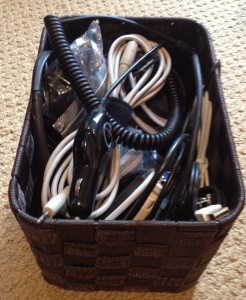![]() This post is part of my new series for the IBM for Midsize Business program, which provides midsize businesses with the tools, expertise and solutions they need to become engines of a smarter planet. Full posts will appear on the InfoManage Technology Report.
This post is part of my new series for the IBM for Midsize Business program, which provides midsize businesses with the tools, expertise and solutions they need to become engines of a smarter planet. Full posts will appear on the InfoManage Technology Report.
I have a system for keeping stuff in my house. When not actively in use, most of my stuff ends up piled on the floor in my home office. When that fills up I move it to more permanent storage in my basement. When that fills up? At this point the attic or the garage become the final resting place of everything I may need someday that I need to keep…just in case.
Am I the only one who has a basket for cables, adapters and power supplies? I keep putting things in but rarely take anything out. And when I do, my process is to dump everything out on the floor, find what I need, then put it all back. Last time I did this I swear I saw a power cord for a Motorola StarTAC. Did I throw it out? No. I wasn’t quite sure, so I left it alone. Please tell me it’s not just me.
Eventually I run out of space to put stuff. At this point, there comes “the purge.” After a great deal of blood, sweat and (sometimes) tears I end up with a curb full of garbage bags. Did I need to keep the stuff in the first place? Sure, some of it. The point is some of the stuff I store, I retrieve and use. The rest of it “expires.”
Circle of Life
Companies are no different. For companies, “stuff” is information — files, email, databases, images — which make up a wide variety of digital content.
Like any living entity, information has a lifecycle: it’s born, it has a useful life and it dies.
For information, death means no longer being relevant or useful. Companies are great at creating information and pretty good at protecting it while it’s relevant. The problem usually comes….. [Full post on: InfoManage Technology Report]
